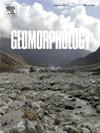Morphological characteristics and evolution processes of the blowouts on fine-grain armored paleodunes in the eastern Qaidam Basin, Tibetan Plateau
IF 3.1
2区 地球科学
Q2 GEOGRAPHY, PHYSICAL
引用次数: 0
Abstract
Blowouts are essential wind-erosion landforms, representing the reactivation of fixed dunes and initiation of desertification. Blowouts occurring on stabilized paleodunes have received less attention than the more common, smaller and shallower blowouts within loose sand surfaces. We explored the geomorphic characteristics, evolutionary processes, and influencing factors of a unique type of blowout in the eastern Qaidam Basin, Tibetan Plateau that forms on paleodunes armored with thick crusts of fine-grained loess or fluvial sediments. Altogether, 1569 blowouts were mapped and analyzed on Google Earth and 24 blowouts were studied in the field. The presence of hard crusts, along with associated undercutting-collapsing expansion model, contributes to their distinct morphological features such as steep sidewalls, sharp rims, irregular shapes, and diverse sand lobe types. These blowouts, with prolonged evolutionary cycles at centennial to millennial scales, are significantly larger sizes than active dune blowouts and generate substantial dust emissions. Blowout shapes gradually become more regular approaching ellipticity with their orientations progressively aligning with the prevailing sand-driving wind direction. Blowout lengths were found to extend faster than their widths that in turn widen faster than their depths. In addition, their areas and lengths altogether increase faster than those of their deposition lobes. The formation and evolution of this special type of blowout are mainly attributed to climatic, sedimentological, and morphological factors which are associated with the destruction of the crusts and release of paleodune sand. Beyond providing new insight into the broader mechanisms of wind erosion and desertification in the Tibetan Plateau, this study appears relevant for many terrestrial and planetary aeolian environments.
青藏高原柴达木盆地东部细粒甲状古丘井喷形态特征及演化过程
井喷是重要的风蚀地貌,代表着固定沙丘的重新激活和沙漠化的开始。在稳定的古丘上发生的井喷受到的关注比在松散的沙质表面上更常见、更小、更浅的井喷要少。探讨了青藏高原柴达木盆地东部一种独特的井喷类型的地貌特征、演化过程及其影响因素。该类型井喷形成于细粒黄土或河流沉积物厚壳古丘上。谷歌地球上总共绘制和分析了1569个井喷,并在现场研究了24个井喷。硬地壳的存在,以及相关的下切-坍塌膨胀模型,形成了其独特的形态特征,如陡峭的侧壁、尖锐的边缘、不规则的形状和多样的砂瓣类型。这些井喷在百年至千年的尺度上具有较长的进化周期,其规模明显大于活跃的沙丘井喷,并产生大量的粉尘排放。井喷形状逐渐趋于规则,接近椭圆形,其方向逐渐与盛行的起沙风向对齐。研究发现,井喷长度的扩展速度快于井喷宽度,而井喷宽度的扩展速度又快于井喷深度。此外,它们的面积和长度总和比沉积叶的面积和长度增加得更快。这一特殊类型井喷的形成和演化主要受气候、沉积和地貌等因素的影响,这些因素与地壳的破坏和古寒带砂的释放有关。除了为青藏高原风蚀和沙漠化的更广泛机制提供新的见解之外,这项研究似乎与许多陆地和行星风成环境有关。
本文章由计算机程序翻译,如有差异,请以英文原文为准。
求助全文
约1分钟内获得全文
求助全文
来源期刊

Geomorphology
地学-地球科学综合
CiteScore
8.00
自引率
10.30%
发文量
309
审稿时长
3.4 months
期刊介绍:
Our journal''s scope includes geomorphic themes of: tectonics and regional structure; glacial processes and landforms; fluvial sequences, Quaternary environmental change and dating; fluvial processes and landforms; mass movement, slopes and periglacial processes; hillslopes and soil erosion; weathering, karst and soils; aeolian processes and landforms, coastal dunes and arid environments; coastal and marine processes, estuaries and lakes; modelling, theoretical and quantitative geomorphology; DEM, GIS and remote sensing methods and applications; hazards, applied and planetary geomorphology; and volcanics.
 求助内容:
求助内容: 应助结果提醒方式:
应助结果提醒方式:


